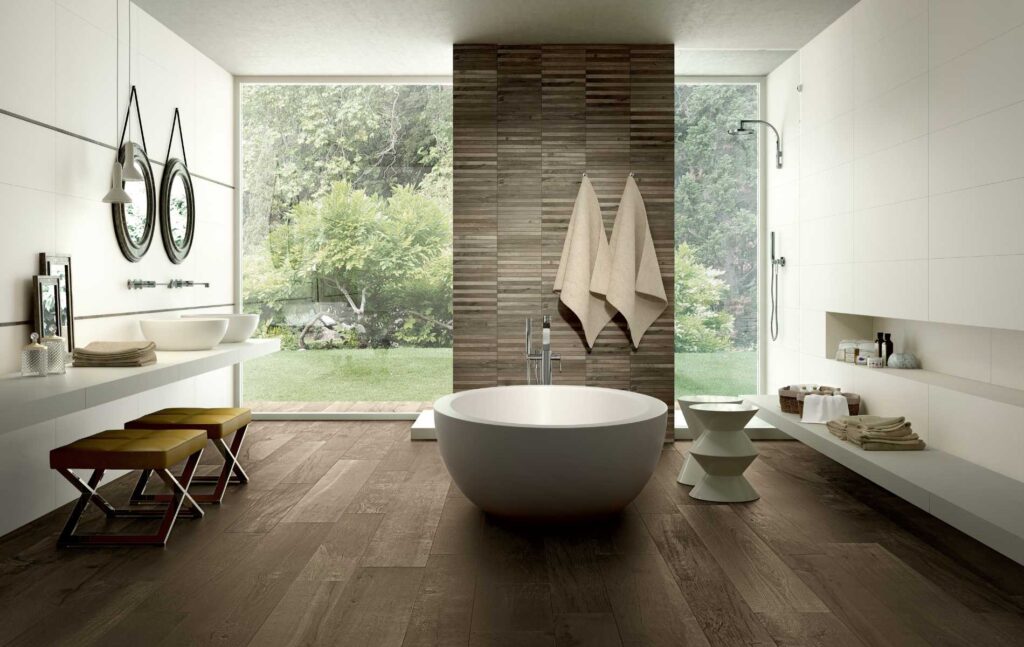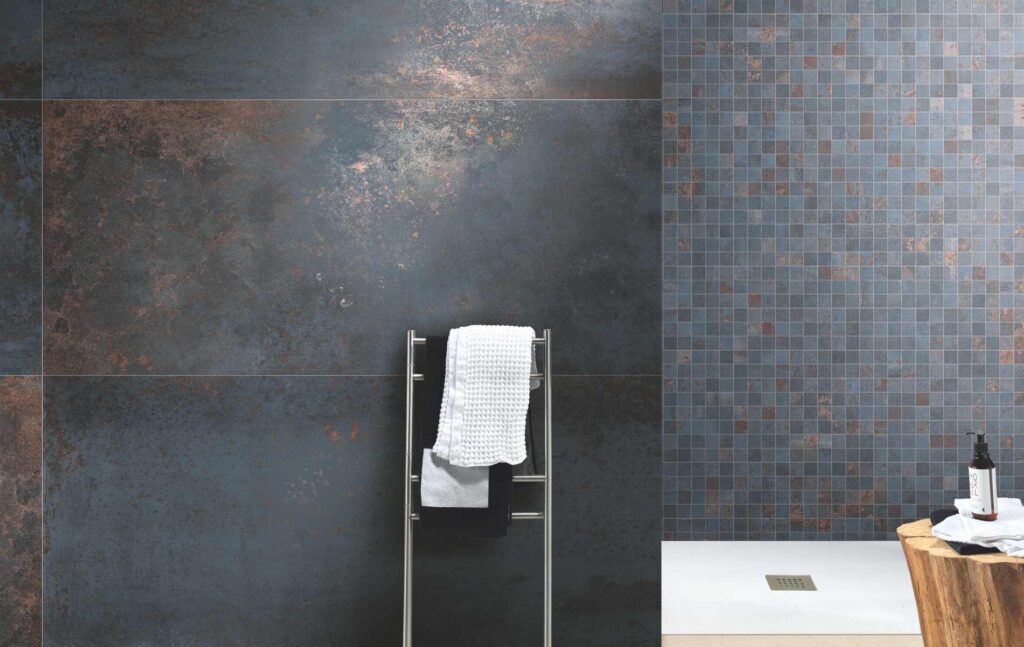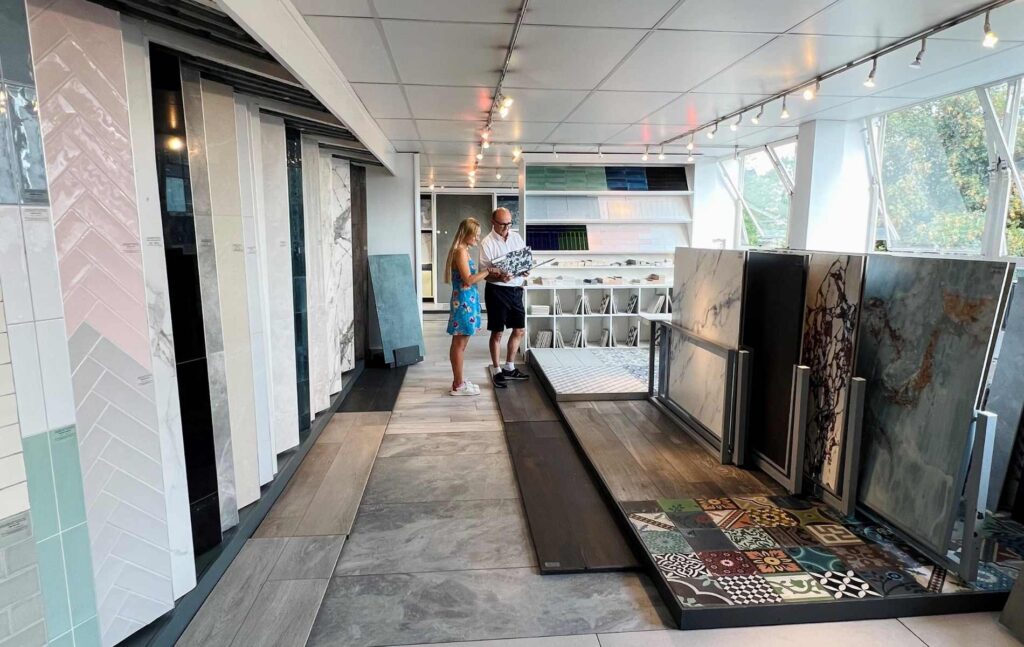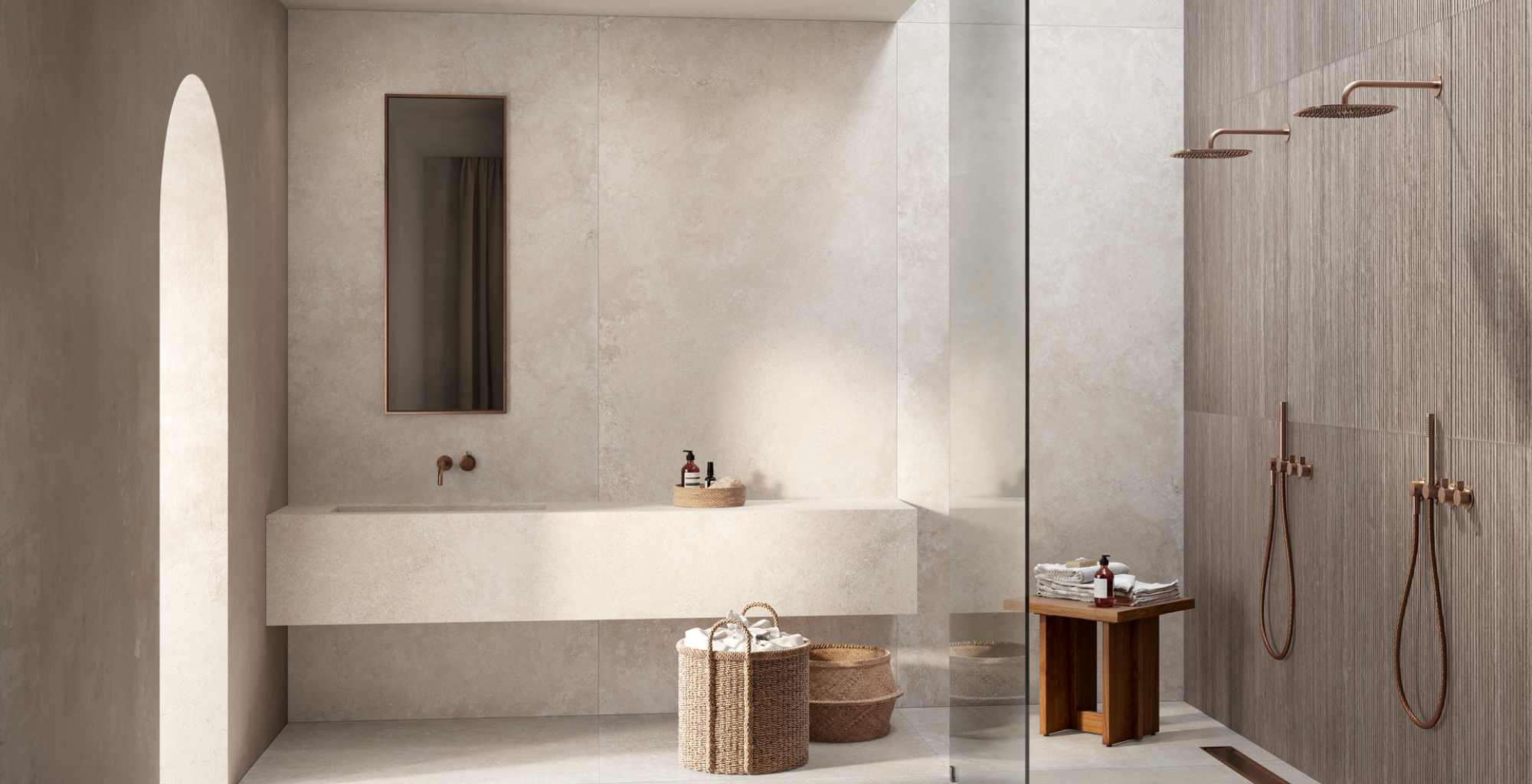Knowing how to choose tiles for a bathroom is one of the most important parts when designing a bathroom, not just for practical reasons but for how they define the entire look and feel of the space.
From layout and maintenance to aesthetics, we hear from Jo Oliver, Director of Stone and Ceramic Warehouse on how to choose tiles for a bathroom.
Credit: Stone and Ceramic Warehouse, Type: Tivoli, Travertine-effect porcelain range
Why is it Important to Choose the Right Bathroom Tiles?
Tiles can make or break a great bathroom. But knowing how to choose tiles for a bathroom can take time and often expert advice.
The layout of plumbing, the location and space between sanitary ware is extremely important, but how the room is decorated (i.e. with tiles and potentially paint or wallpaper) is what people really look at when they enter.
Your tile choice instantly sets the tone for the space. It can make the room feel larger, cosier, brighter, more luxurious, or even spa-like. The right bathroom tiles blend form and function, delivering style while withstanding daily wear and moisture.
That first impression matters and tiles are often the first thing guests notice.
Why Are Tiles a Good Choice for the Bathroom?
Tiles are an excellent choice for bathrooms—not only for their style but also for their practicality. You can choose from a wide range of tile types, with porcelain tiles standing out as one of the most durable options. Thanks to their extremely low porosity, they’re resistant to moisture and incredibly easy to clean. Porcelain tiles are also ideal for use with underfloor heating, and they come in a variety of finishes, including anti-slip options—perfect for tailoring the surface to suit both the style and safety needs of your space.
Jo Oliver, Director at Stone and Ceramic Warehouse
What Are the Different Types of Bathroom Tiles?
Understanding your options is a key part of learning how to choose tiles for a bathroom. Each tile type brings a different feel to a space, so it’s important to find what suits your style, layout and maintenance preferences.
Ceramic Tiles
Ceramic tiles are typically used on walls and often come in small formats, such as brick-style shapes. They can have a matt or shiny glazed finish, which can help reflect light and add visual interest to a room.
These tiles work well in splash zones, behind basins, or on feature walls, especially where you want to introduce texture or colour.
Porcelain Tiles
Porcelain tiles are made from natural clay and fired at very high temperatures, which makes them nearly non‑porous and exceptionally hard-wearing. They’re available in plain, patterned designs or finishes that convincingly mimic natural materials like limestone, marble and even wood.
They come in a full range of sizes, from small mosaics, standard 60x60cm tiles to large-format slabs from 120 × 280 cm to a whopping 162 x 324cm. Their low porosity also means they require almost no maintenance.
Because porcelain is so durable and comes in many finishes, it’s one of the most versatile options. You can create a seamless look by using the same tiles on both walls and floors, or differentiate zones by mixing sizes, colours and finishes.
Marble Tiles
Marble tiles are softer than porcelain and ceramic, and offer a classic look. Each tile features unique veining, as marble is a natural stone, which means no two pieces are exactly the same.
Because marble is porous, it’s susceptible to staining and scratching. Tiles must be sealed before installation, especially in bathrooms, where moisture levels are high. It’s important to have a maintenance schedule to reseal marble tiles to protect the surface from water and product marks. A good ongoing cleaning regime is key to keeping marble tiles looking their best, avoiding harsh cleaners such as vinegar and bleach.
As marble tiles are a natural material, the appearance of marble will vary depending on the part of the quarry it comes from. So it’s essential to be comfortable with variation from the sample to the final tile.

Limestone tiles
Limestone tiles also offer a classic, natural aesthetic, but like marble, they are softer than porcelain and require careful maintenance.
They have subtle tonal variation and a chalkier texture, which gives them a relaxed, organic feel. However, like marble, limestone tiles need to be sealed to help protect against water and staining.
Tip: Regardless of the type of limestone tile, they are sensitive to acid. When cleaning, use a pH-neutral detergent diluted in warm water. If you’re using them as floor tiles, vacuum or sweep before cleaning and generally to remove grit.
Marble and limestone tiles require a little TLC, as opposed to man made products. They are not suitable for those who like to use strong cleaners in the bathrooms as this will damage the tiles.
Jo Oliver, Director at Stone and Ceramic Warehouse
Glass Tiles
Glass tiles are generally used in mosaic format, most often on walls, and are also common in swimming pools and saunas. They can add shimmer, reflect light and are a great way to lift more neutral tiles with a bit of colour or contrast.
There are many pretty colours available with glass tiles, from soft pastels to bold jewel tones. Because of their glossy surface, they’re ideal for creating light-enhancing feature walls, splashbacks or shower niches.
What Are the Different Types of Tiling Layouts?
Different tile layouts can completely transform how a bathroom looks and feels. The right layout can make a space appear wider, taller or add striking texture so it’s worth considering more than just the type of tile itself.
Straight bond
This is the simplest layout and often the most economical in terms of tile wastage, and best suited to small spaces. Tiles are laid so all the lines run straight, corner to corner, creating a clean and contemporary look.

Credit: Stone and Ceramic Warehouse, Type: Small format tiles. Name: Park Lane Colour: Primrose
Brick bond
As the name suggests, tiles are laid in a staggered brick-like pattern. This layout is popular for small brick tiles on walls or with larger tiles, like 60x90cm, on floors for a more traditional or rustic feel.
Herringbone
Herringbone is a stylish, eye-catching pattern that can elongate a space or add a sense of luxury.
Jo shared that Herringbone tiles were:
A super popular choice for the 2020’s! You can do this with wood effect tiles or a colourful glossy wall tile as a feature in a shower room.

Credit: Stone and Ceramic Warehouse, Type: Park Lane Burgundy
What type of designs do porcelain and ceramic tiles come in?
Bathrooms are a great place to experiment with different patterns and colours so don’t be afraid to do so.
For example, you could have a feature wall or have tiles on a shower wall or behind your sink.
Wood Effect tiles
Wood effect tiles are popular for bathrooms where you want the space to feel a little ‘less bathroomy’. They give a softer, calm and homely look. You can also use them in wet room floors, which is fun!
They’re a great choice if you love the look of timber but want something that’s more water-resistant and low maintenance.

Marble Effect tiles
Marble effect tiles mimic the beautiful veining of traditional marble tiles. These are great in large slabs, as you can achieve a high-end look for a fraction of the price.
These tiles can create a luxurious finish without the high maintenance or cost of real marble, and they’re more resistant to scratching and staining too. They are ideal if you want a sophisticated design with less upkeep.

Credit: Stone and Ceramic Warehouse, Type: Coliseum Statuario polished marble-effect porcelain slabs
Chevron tiles
Chevron tiles are similar to herringbone tiles, but the shape differs with each tile ending in a point, allowing for a seamless zigzag layout.
This bold, geometric aesthetic adds a strong sense of movement and direction and works well on both floors and walls.
Hexagon tiles
Hexagon tiles can come as mosaics on a mesh backing for quick installation or in larger individual pieces. They are generally available in two main formats: small mosaic pieces pre-mounted on mesh backing, or larger individual tiles. They add visual interest and are often laid on floors with a simpler wall tile to balance the space.
Hexagons offer a modern, geometric feel and are a great way to zone different areas within a bathroom, like under a freestanding bath or in a shower area.
Fishscale tiles
Fishscale tiles, also known as fan tiles, mermaid tiles or fish scale tiles, are typically available as mosaics and look fantastic on walls. They can be laid either with the ‘scales’ pointing up or down, it just depends on what you prefer! They can look fantastic when laid to half height on a wall, and finishing with the top of the fishscale design for a scalloped effect.
These tiles are brilliant for injecting texture and a sense of movement, with the curved shape adding softness to a space.
Terrazzo tiles
Terrazzo tiles are a great way to add colour and detail, as they feature lots of small ‘chips’ or fragments in contrasting shades. Porcelain terrazzo tiles may be ‘full body’, where the chips are embedded throughout the tile and visible on the edges, or printed with a high-definition surface design.
These tiles are a brilliant way to introduce movement and texture without committing to a strong or overly bold pattern.
Should You Use Small or Large Format Tiles?
Great question! This is all down to personal preference as to the look you want to achieve.
Jo Oliver, Director at Stone and Ceramic Warehouse
If you want to make a small space (or even a large space), feel spacious, opting for large tiles will make the room feel less busy and create a sense of space. If you want to add texture, visual interest, colour or a feature wall then smaller tiles can be best. However, tiling with small tiles does result in more grout lines. So opting for larger tiles, especially in the wet areas such as in showers will mean less ongoing maintenance in the future.

Do You Need Different Tiles for the Walls and Floor?
Not necessarily. Porcelain tiles are OK for walls and floor, whereas most ceramic tiles are wall only. However, when choosing floor tiles for a bathroom, pay attention to the anti-slip rating! If you are using tile in a wet room shower, you need a higher anti slip tile than a downstairs cloakroom for example. A good tile company will be able to run through the best option for the intended use.
Important tip: Always check for slip-resistance (look for PTV and R-ratings) and make sure floor tiles are suitable for wet environments.
If you have a very dark floor tile in a small bathroom, it can make the room feel smaller as it draws attention to the limited floor space. Very dark tiles can also show dust and dirt more easily, which means they tend to require more upkeep to remain looking clean.
Some people prefer using darker floor tiles to break up the space or add contrast, but pairing a dark floor with pale or white walls can sometimes feel a bit cramped or even slightly dated.
Using the same colour on both walls and floors in a light to mid-tone generally helps the space feel more open and cohesive. Lighter floor tiles also reflect more light, which can make a room appear larger and brighter overall.
Where can I buy bathroom tiles?
At Stone and Ceramic Warehouse, there are two large showrooms with a wide range of displays to help you visualise how the tiles will look in your space. It’s a great way to explore different layouts, materials and finishes in person before making a decision.
We’re not your typical tile shop. Our team is a unique blend of experienced tile industry professionals and creative designers who genuinely care about helping you find the perfect tiles for your space. We focus on more than just aesthetics—we make sure the tiles you choose are both beautiful and fit for purpose.
We stay ahead of the curve with the latest tile trends and offer free samples to help you make the right choice. Visit our showroom to speak to us about how to choose tiles for a bathroom, explore bathroom tiles in person, or order samples online where a sample box will be posted to you.
Jo Oliver, Director at Stone and Ceramic Warehouse
Tile samples are really important to see how the colour works in your home and for you to feel the textures between one tile to the next, something you simply can’t do by looking at images on a screen alone.
We also have a wide selection of past projects to inspire you, showing how different tiles look in real homes. These are available to browse in our showrooms, as well as on our Instagram and Facebook channels.
With a huge number of tiles in stock across our two warehouses, most orders are available for same-day collection or we can deliver within a couple of days (sometimes even next day!).

Considering a Move? Think About the Bathroom Too
Whether you’re looking for a home with the potential to renovate or refresh a bathroom, our expert estate agents can help. Browse our latest listings or contact our team who would be happy to assist.





